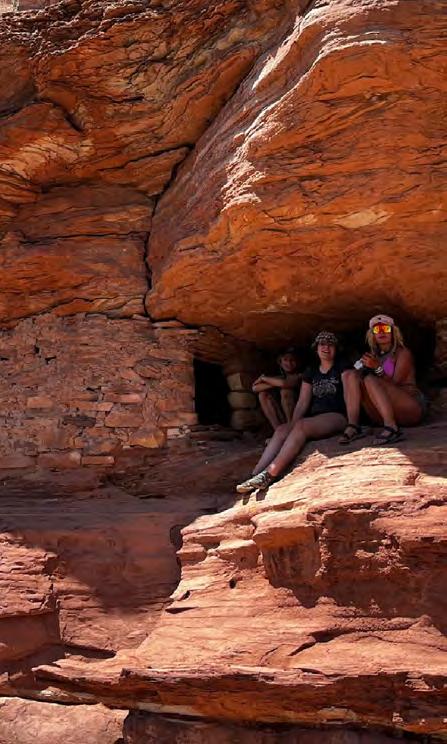
3 minute read
TROUBLED TIMES IN DRY LANDS
from Water in the West
At the outside of a horseshoe bend in the river, we spotted an openinginthetamariskand eddiedout.Aftertyingup ourcanoes,wehikedupafainttrailthat ledtothebaseofasandstonewall.Then wesawit:Asmallcavefifteenfeetabove usthatwasjustlargeenoughforasmall family. Flat, irregular stones, held together with a mud-like mortar, enclosedthe dwelling.I scamperedup a steep slab of rock in my sandals before carefullytraversingtowardstheopening. Juniper branches had been cut to frame the door, and over seven hundred years later, the rectangular entry was still intact. I turned upriver and saw a columnar structure across the wash that waswithinyellingdistance.Perhapsthey positioned a lookout there to watch for marauding enemies drifting downstream insearchoffoodduringtryingtimes.

Advertisement
The Anasazi, otherwise known as The Ancient Ones or the Ancenstral Puebloans, are responsible for constructing North America’s largest buildingsuntilChicago’sskyscraperswere erected in the 1880s. However, after managing to survive in the fragile environment of the desert Southwest for hundreds of years, this same group of people eventually ‘disappeared’ Archaeological evidence suggests that they abandoned the area between 11001300CE. Their story is one that is being repeated today as population growth, climatechangeandalackofconservation have all contributed to an uncertain future for people living in the American Southwest.
The Ancestral Puebloan’s story makes it clear that living in this arid region requires an understanding that water is scarce; therefore, when managing water tremendous foresight, cooperation and sacrificeisrequired.TheU.S.southwestis a fragile environment and a, “marginal environment for agriculture,” and as a result the Ancestral Puebloans had to experiment with dry land agriculture, planting close to the water table, and collecting water runoff in irrigation ditches (Diamond, 2011, p.137). As their population grew in places like Chaco Canyon,“itbecamedangerouslytempting toexpandagriculture,inwetdecadeswith favorablegrowingconditions,into marginal areas with less reliable springs andgroundwater”(Diamond,2011,p.141). Inessence,theypushedthelimitsofwhat was possible and then paid a heavy price when their agriculture needs exceeded what the land could provide. Simultaneously, as the population increased, the demand for wood for building and heating needs expanded as well.
THEIR STORY IS ONE THAT IS BEING REPEATED TODAY AS POPULATION GROWTH, CLIMATE CHANGE AND A LACK OF CONSERVATION HAVE ALL CONTRIBUTED TO AN UNCERTAIN FUTURE FOR PEOPLE LIVING IN THE AMERICAN SOUTHWEST.
Archaeologists have been able to examine mouse excrement from middens to get a more clear view of how the environmental conditions changed during that time. Evidence suggests that, “middens date[ing] after A.D. 1000 lacked pinyon and juniper, showing that the woodland had then become completely destroyed” (Diamond, 2011, p.147). This date coincides with a big spurt in constructioninChacoCanyon,whichtook place in 1029CE, the same decade when conditions were particularly wet. The rise and fall of their population matched a rise and fall in agriculture, which in turn matched a rise and fall in precipitation levels. In Collapse, Jared Diamond concludes his investigation into the disappearanceoftheAncestralPuebloans from this region arguing that the, “people came to be living increasingly close to the margin of what the environment could support,” but the, “proverbial last straw that broke the camel's back, was the droughtthatfinallypushedChacoansover theedge;adroughtthatasocietylivingat a lower population density could have survived”(Diamond,2011,p.156).
Five hundred years later, as Americans migratedwestinthelate1800s,theytoo quickly became the key to survival in the West… because to grow anything substantialwestof,say,Kansas,youcan’t depend on rain” (2019, p.24). In the early 1900s as more and more dams were built and engineers were able to transport water from the Colorado River basin to faraway places like Los Angeles, modern enginuity allowed population densities in theWestthateventuallytaxedthecarrying capacity of the land. Today, “the unmitigated forces of growth and drought exacerbate the problem. The Colorado River Basin has been in what the Department of the Interior calls a 'historic extended drought' since 2000 and a good numberof the fastest-growingcitiesin the country,likeSaltLakeCity,dependonthe basin, and on the Green in particular” (Hansman,2019,p.32). when it came to water, and one where changes in climate and an inability to adapt to changing times led to conditions that became so taxing that the Ancient Ones had to abandon the place they calledhomeforoverfivehundredyears. quickly came to realize that existence in the American Southwest is impossible without reliable access to water. They immediately surmised that rerouting and storing water, as well as eventually ‘securing’ access to it with legal rights were essential needs in the West. In her book,Downriver, Heather Hansman notes that,"Irrigationandaccesstowater

In one hundred and fifty years we are approaching that same limit. As Hansman argues,"it'stimethatwefindnewwaysof thinking about living in this arid land, because the old ways will lead to our demise".
Afterreturningtoourcanoes,wepaddled back into the main current of the Green. Theserpentinenatureofthecanyonwalls and the river's course made it hard to knowwhatmightbearoundthenextbend, fortheriverandforus.

Today, California, Arizona, Nevada, Utah, Colorado and Wyoming are all scrambling to figure out what legislation needs to pass to ensure that no cities become cut off from the water they have come to rely on. Both Lake Powell and Lake Mead are literally drying up and approaching 'dead pool' where water levels will not be high enough to pump waterthroughtheturbines.Asaresult,we find ourselves in similar situation to the one that befell the Ancestral Puebloans, onewheredemandswellexceededsupply










